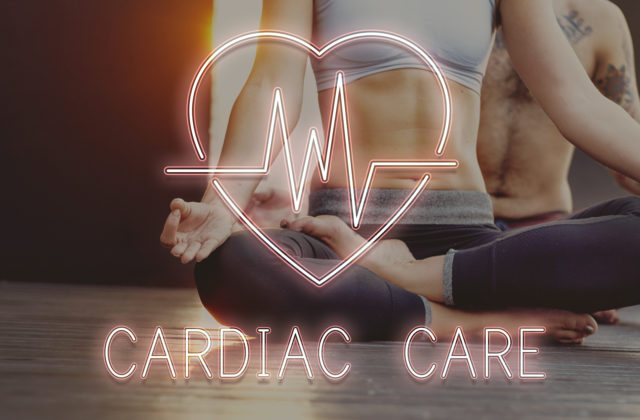
The Centers for Disease Control and Prevention reports that 1 in every 4 American deaths is directly related to heart disease. Conditions like coronary heart disease, cardiomyopathy, and other cardiovascular ailments kill over 600,000 people each year.
Massage therapy offers clients with cardiovascular issues many benefits that can help them improve their cardiovascular health and reduce their risk of stroke and heart attack.
What Contributes to Cardiovascular Disease?
There are three major factors that contribute to the development of heart disease.
These conditions are caused by structural abnormalities present at the time of birth.
- Viral infections
Myocarditis is damage to the heart due to certain viruses.
- Lifestyle Choices
Daily habits are currently the biggest contributor to heart disease.
- Smoking
- Poor diet
- Lack of exercise
- Diabetes
- Obesity
- Chronic stress
How Stress and Pain Affect the Heart
When a person experiences a painful or stressful event, the brain releases the hormones cortisol and adrenaline. These chemicals prepare the body to fight or run away from dangerous situations. The body responds by tensing muscles, shortening the breath, and increasing the heart rate.
This response, however, is only supposed to be short-term. Too much of these hormones can fatigue the body, especially the cardiovascular system. Without relief, long-term stress or chronic pain will weaken the heart muscle. Combined with less-than-healthy lifestyle choices, these factors can lead to heart disease.
How Massage Supports Cardiovascular Health
Massage therapy helps patients with cardiac issues address some of the factors that may be contributing to their condition. In conjunction with doctor-prescribed protocols, massage also helps patients manage some of the side effects of treatment.
- Induce states of physical and mental relaxation, which can help alleviate the effects of chronic stress and anxiety on the whole body.
- Loosen tight muscles and increase blood flow, which improves overall circulation and decreases the chances of stroke-causing clots.
- Alleviate chronic pain, which helps interrupt the brain’s “fight or flight” response.
- Reduce anxiety before or after surgical procedures.
Some common side effects from traditional drug therapies used to treat heart disease can be treated effectively with massage.
- Abdominal pain
- Headache
- Muscle aches
Precautions
While massage is generally safe and effective, there are some cautions to keep in mind when working with cardiac patients.
- Those on blood thinning drugs should avoid vigorous or deep tissue techniques, as these can cause bruising, inflammation, or tissue damage.
- Massage is not recommended for those with low blood pressure.
- Patients with a history of blood clots should avoid Swedish techniques.
- Therapists should avoid manipulating the area around pacemakers, stents, or other implanted devices.
- Patients with signs of congestive heart failure should start with short massages, and slowly work up to longer sessions, as tolerated.
Recent studies also who that consistent massage therapy can reduce blood pressure and heart rate. High blood pressure and rate are major factors in heart attack risk.
Patients who combine traditional medical treatments with massage techniques experience an increase in energy, physical relaxation, and mental focus. This can help them recover faster from surgical procedures, or avoid major cardiovascular events.
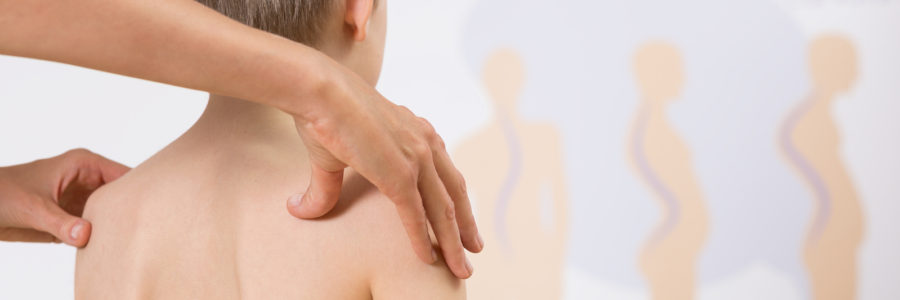
Scoliosis and Massage Therapy
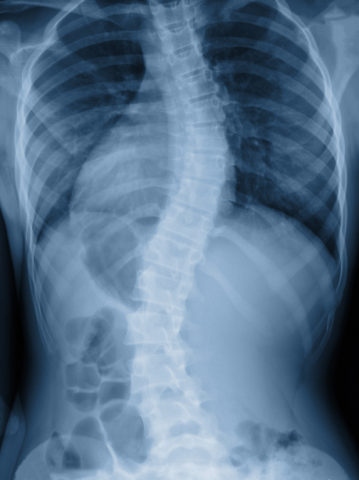
Over 30% of the American population has some form of scoliosis. You may have already helped clients who suffer from this condition in your regular bodywork or therapy practice. While traditional treatments vary, massage therapy is a safe addition to any client’s treatment plan.
What is Scoliosis?
Scoliosis is a condition of the spine. It causes the spine to curve left or right into a distinctive “S” or “C” shape. The spine compresses. This compression throws off the patient’s balance, and can contribute to a variety of health complications.
- Sore, painful muscles
- Difficult, stiff movement
- Hunch back
- Lung and heart problems
- Numbness
- Muscle weakness
If left untreated, the spine will continue to curve. This can lead to nerve, joint, and ligaments damage, as well as permanent disability.
What Causes Scoliosis?
Most scoliosis cases are classified as idiopathic. That means there is no known cause.
For about 20% of cases, doctors can point to a definite root condition. These cases are classified as structural or non-structural.
Structural scoliosis causes the spine to bend into a rigid curve that cannot be corrected. It is caused by underlying conditions like
- Cerebral palsy
- Muscular dystrophy
- Birth defects
- Tumors
- Infections
- Marfan’s or Down Syndrome, or similar genetic disorders
The spine of a patient suffering from non-structural scoliosis works normally. The characteristic curve is caused by injury, weakness, or illness of surrounding body parts. When the cause is treated, non-structural scoliosis generally disappears.
Scoliosis can also be developed while still in the womb. Congenital damage to growing vertebrae can cause the spine to curve, not divide properly, or not grow completely. Some patients with congenital scoliosis are not diagnosed until they are between the ages of 10 and 15. During this time, many children go through several growth spurts, which makes structural malformations more noticeable.
Degenerative scoliosis is caused by the wearing of joints and discs in adults. Their damaged joints cause the surrounding muscles to strain, which leads to a curved spine.
Massage Therapy for Scoliosis Patients
While scoliosis massage cannot correct curved or twisted bones, including the spine, it can help clients reduce pain and increase mobility.
- Massage relaxes muscles that are pulled out of place by shifted bone structures, which can significantly calm tight, uncomfortable sensations.
- Deep tissue techniques increase blood circulation and break up scar tissues, which makes it easier for patients to move freely.
- Patients who receive massage prior to chiropractic or neuromuscular therapies report better results from these treatments.
- Massage is known to soothe the mind as well as the body. A decrease in mental stress is linked to a better ability to deal with chronic pain issues.
Early and regular scoliosis massage therapy, in conjunction with standard medical treatments like exercise and the use of a brace, can help scoliosis patients avoid complicated surgeries.
There is no cure for scoliosis. However, it is highly manageable. The goal of treatment is to reduce the progression of spine curvature, reduce discomfort, and restore or improve mobility. Scoliosis Massage therapy can help your client achieve these goals more quickly than with standard treatments alone.
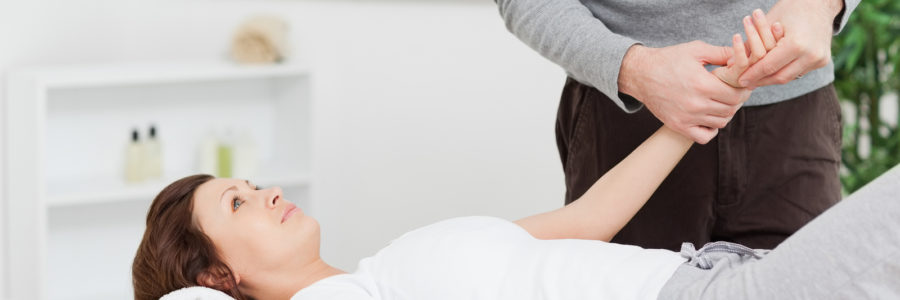
Carpal Tunnel Syndrome: What is it? And How Do I Relieve it?
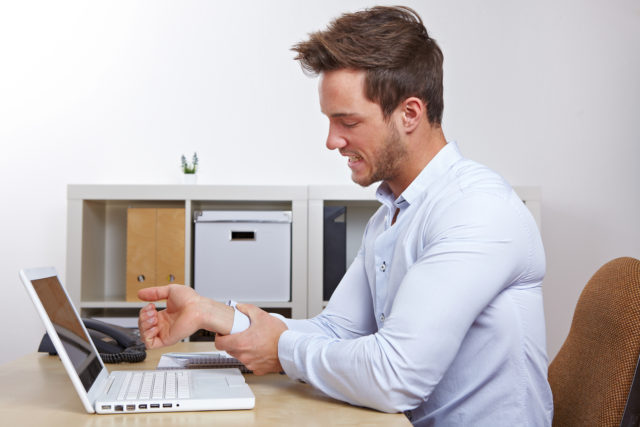
In our fast-paced, technology-addicted world, Carpal Tunnel Syndrome is a common complaint. The stiff muscles and shooting pain sufferers experience can have a significantly negative impact on daily life. As a professional therapist or bodyworker, it’s likely you will work with a client who has Carpal Tunnel Syndrome. Understanding this increasingly common condition will allow you to help your clients achieve maximum relief.
What is Carpal Tunnel Syndrome?
Carpal Tunnel Syndrome occurs when pressure is exerted on the median nerve that runs through the arm and wrist. This nerve controls motion and feeling in all digits except the little finger. When the nerve reaches the wrist, it runs through a narrow structure of bone and ligament called the carpal tunnel. Constant pressure on the nerve causes it to press against the bony parts of the structure. If left untreated, the nerve will sustain damage that can cause a variety of symptoms.
- Numbness
- Loss of muscle strength
- Tingling
- Pain in fingers, hand, or forearm
- Many sufferers first notice their symptoms at night.
Getting a Diagnosis
As always, patients should seek an official diagnosis from their primary medical physician. The doctor will start with a medical history. People with arthritis, hypothyroidism, and diabetes are at higher risk of developing the condition. The doctor will ask about recent injuries or accidents affecting the head, shoulders, arms, or hands. They will also examine your daily routine. Those with jobs that require small, repetitive movements of the hands and wrists have a greater chance of their symptoms being caused by Carpal Tunnel Syndrome.
The doctor then performs a physical examination. They will check muscle strength, sensation (the ability to feel), and the general appearance of the head, neck, shoulders, arms, wrists, and hands. Some specialists may order blood or nerve tests to verify results.
Traditional Treatment Methods
Depending on the severity of symptoms, conventional treatment options for Carpal Tunnel Syndrome vary. Milder symptoms can often be treated effectively at home.
- Stop any activities that may be causing symptoms. If that is not possible, try to rest your wrists and hands often.
- Place an ice pack on wrists for 10-15 minutes at a time up to 2 times per hour to reduce discomfort.
- N-SAIDs, like Ibuprofen or Naproxen Sodium, reduce painful swelling.
- Wearing a wrist splint while sleeping can lessen pressure on the median nerve.
If symptoms are allowed to progress, more severe interventions may be necessary. Powerful anti-inflammatory medications, called corticosteroids, can be prescribed in pill form or injected directly into the wrist. While these medications can significantly reduce pain associated with Carpal Tunnel Syndrome, they do not provide permanent relief. Surgery is an option for the most advanced cases.
Other Self-Treatment Options
There are some simple steps everyone can take to decrease the intensity of symptoms and frequency of attacks caused by Carpal Tunnel Syndrome.
- Regular Stretching
- Get treated for contributing conditions.
- Maintain a healthy weight.
- Quit smoking.
- Exercise regularly.
In addition to lifestyle changes, sufferers should take measures to protect their wrists and hands.
- Keep wrists elevated when using a keyboard.
- Keep shoulders relaxed and at the sides while typing or working.
- Use the whole hand to grip items rather than just fingers.
- Switch hands during repetitive motions.
Massage Therapy for Natural Pain Relief
Certain massage techniques have been proven to relax tight muscles and fascia in the arm and shoulder and reduce pressure on the median nerve. For clients with Carpal Tunnel Syndrome, a muscle specific massage will help address holding patterns associated with repetitive use while also increasing blood flow to the affected region. Leaving your client feeling loose, refreshed, and hopefully pain-free.
Contact us today to learn more about how massage therapy can be an effective treatment for carpal tunnel syndrome.
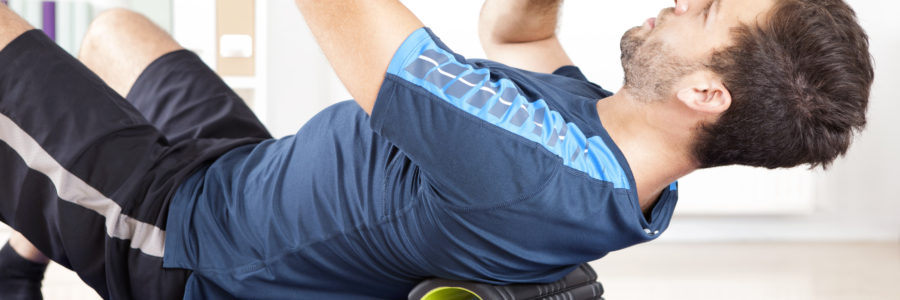
Low Back Pain Relief with These 8 Tips
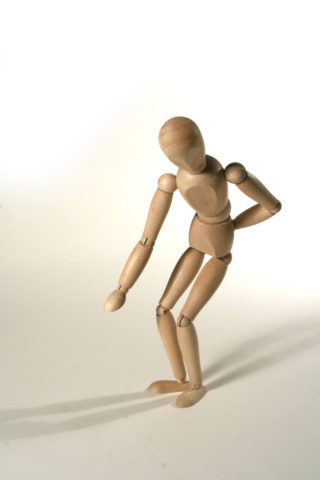
Low back pain is experience by over 80% of Americans during their lifetime. It is one of the most common complaints medical professionals hear. You’ve probably had clients complain about a stiff, achy lower back. Therapeutic massage and any other types of bodywork can relax stressed muscles and temporarily relieve pain from acute attacks. But if your client has chronic low back pain issues, they may need more structured interventions. Offer these tips to help your clients achieve a strong, flexible and injury-free back.
Causes and Impact
Low back pain can result from many causes.
- Injury
- Improper posture
- Sedentary lifestyle
- Strained ligaments
- Medical conditions like disk disease, osteoporosis, cancer, and some infections
Regardless of the cause, the impact on daily life can be immense. Stiff, achy muscles and swollen ligaments make it difficult to perform normal activities. Persistent pain can lead to lost work hours and a lower overall quality of life.
Get Moving
When the pain is at its worst, your client will be looking for fast relief. After therapeutic massages, exercise is the single best solution to muscle pain and tightness.
- Sitting or standing in one position for too long cause tension and pressure that can add up over time. Encourage sedentary clients to get up and exercise. Aerobic activity triggers the release of endorphins. These chemicals reduce your perception of pain, and acts a mild muscle relaxant.
- Regular exercise strengthens weak muscles, which reduces strain on the lower back. Suggest some simple exercises to strengthen your client’s core muscles.
- In addition to aerobic and strengthening exercises, advise your client to include stretches to increase flexibility in tight, knotted areas.
Correct Posture
Talk to your client about using good posture throughout their day.
- Educate your client on the benefits of ergonomically correct workstations and lumbar supports. Maintaining a healthy curve in the spine reduces stress on ligaments, discs, and joints.
- If you do not offer chiropractic services, refer your client to a trusted colleague. Periodic spinal adjustments, in conjunction with therapeutic massage and exercise, will correct misalignments that cause lower back pain.
Relax and Heal
After your massage session, suggest some self-care procedures your client can do at home to help them relax overworked muscles and let their bodies heal.
- Alternate ice and heat. Heat increases the flow of warm, nourishing blood to speed healing. Ice calms irritated nerve endings and decreases painful swelling.
- Talk to your client about sleeping positions. Lying on the side with a pillow between the knees reduces strain on the lower back and hips. Those who prefer to sleep on their backs should place a pillow under their knees. Sleeping on the stomach should be avoided.
- Some lower back pain has been linked to mental or emotional stress. Suggest balancing activities that soothe mind and body, like yoga, meditation, or deep breathing exercises.
Talk to your client about their pain. Take a few minutes to help them make a personalized plan, tailored to their current level of physical ability, pain tolerance, and commitment.
Low back pain doesn’t have to take over your client’s life. With the right combination of self-care and professional treatment, you can help your clients achieve a strong, flexible, and healthy spine.
Learn more today about how you can help people with low back pain with a career in massage therapy

Easy Spring Exercises for Summer Preparation
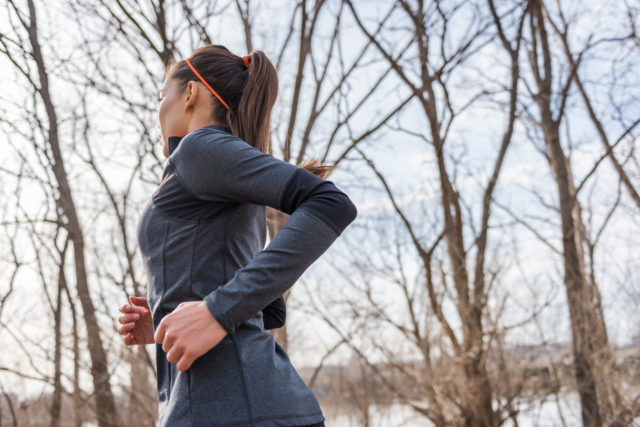
With winter’s end looming near, the thoughts of many are turning to shorts and bikini season. After months of thick, shapeless sweaters and holiday indulgence, your clients are probably looking for simple spring exercises to shed extra pounds and firm up neglected muscles. Offer these easy spring exercises to help your client achieve a their beach-ready body.
The Basics
Before starting any workout plan or routine, have your client check with their primary physician to make sure they are healthy enough.
The effectiveness of any exercise routine depends on commitment and consistency. Even light, low-intensity workouts can have a significant impact on general health and physical appearance, if done on a regular basis. Workouts should be done at least 3 times per week. For faster results, do spring exercises up to five times per week.
Most fitness experts suggest 30-60 minutes of vigorous activity each day. Those who can’t commit to a large block of time will still see benefits with a series of 10-15 minute workouts.
- Always start with a light warm-up, like jogging in place.
- Fat-burning aerobic activities are just as important as muscle-toning moves.
- Start off easy. Weight and repetitions can always be added later. Don’t overdo it!
- Finish your spring exercises with some easy stretches.
- You can’t out-exercise a bad diet. Caution clients to limit calories for ultimate results.
- Hydration is important. Health experts suggest at least 64 ounces of water each day.
Easy Spring Exercises
A beach-ready body has toned arms, legs, buttocks, and a strong core. These simple moves can add some perk to your clients’ spring exercises. All of these easy spring exercises can be done without special equipment.
- Burpees
Burpees are a wonder exercise. There are variations for every fitness level. When done correctly, Burpees hit almost every major muscle group in the body, but are especially good for the quads, abs, and shoulders. They also increase heart rate to aerobic levels when done quickly.
- Lunges and Squats
Sleek, muscular leg and gluteal muscles are the best accessories for summer outfits. Lunges and squats sculpt and strengthen the quadriceps, gluteus maximus, and hamstrings. Add in some weighted arm motions to increase heart rate to fat burning levels.
- Curls
Bicep and triceps curls focus on two out of three major muscle groups in the arm. The triceps sit at the back of the arm and can become loose, flabby, and unattractive from disuse. Curls with hand weights, or using a machine at the gym, can reduce unflattering pockets of cellulite.
- Planks
One simple spring exercise that is guaranteed to challenge is the plank. Planks can sculpt abs without a single crunch or sit-up. They also work the glutes, back, and chest for an all-over toning session. This move can be easily modified to avoid pressure on injured body parts.
- Bridges
Bridges target gluteal muscles, where stubborn pockets of fat can be hard to shape up. They also strengthen the hamstring muscles in the back of the leg for a smoother looking limb.
The number of sets and repetitions depends on current physical condition. Those who are just starting their fitness journey should shoot for one set of 15 repetitions of each move (hold plank for 15 seconds), and add sets as strength increases. Those who are more active should add 3 to 4 sets of 15 repetitions to their regular spring exercises.
Help your client achieve their best summer body. Get them started with these easy spring exercises today, and they will be sure to thank you in a few weeks!
Bookkeeping & Taxes in Massage

The dreams of owning your own business are layered with the benefits of doing so: making your own schedule, doing something you love, being your own boss, leaving the time clock and name badge to the annals of history. You may not, however, be prepared for the required work that must be done as owner or co-owner of a business.
If you purposely or accidentally neglect massage therapy bookkeeping requirements, you may have to pay for it later. It is better to be prepared, organized, and aligned with both state and federal requirements for entrepreneurs so that you can focus even more of your energies on the mission of your massage therapy business.
Tips for Massage Therapy Bookkeeping and Tax Requirements as an Independent Massage Therapist
- Get educated, knowledgeable, and licensed in the field. There are great massage therapy programs available to you wherever you are located. To be in compliance in most states, you will have to provide licensure. A good massage therapy program will also give instruction about how to run a business, how to file with the state revenue departments and the IRS, and how to keep the paperwork under control.
- Taxes – Taxes can be the bane of any business owner, yet they are mandatory. It is best to have a system that works for you. While some massage therapists may choose to do their own personal taxes or quarterly business taxes, many also contract with a licensed tax professional. There are books and online courses available for learning the process of taxation, but as other therapists therapists for advice.
- Keep accurate and precise financial records – The key to efficiency in massage therapy bookkeeping is routine. Figure out a system that works for you on a daily basis and then keep it. Having accurate, precise records of your business expenses, appointments/sessions, and income will save you both time and money when the records are needed. Whether you are using a computer-based system, cloud-based system, or file folder system, keep it organized. Poor record keeping inevitably leads to lost time, and as a small business owner, time has financial value.
- Keep thorough records – No one ever wants to be a part of a legal suit, but it can happen. Medical and health services professionals are often called as trusted witnesses for a variety of legal suits. When this happens, you want to have records that explains the specific reasons each patient was treated, the ailment or reason for their making the appointment, and the level of comfort after.
- Estimate monthly expenses – One of the basic demands of owning a business is estimating your projected expenses so that you can create a reasonable, reliable budget. Many business owners estimate both monthly and annually, adjusting based upon need.
- Familiarize yourself with accounting software – If you do decide to save on the cost of hiring a tax professional, you will need to look at various accounting software packages that keep your massage therapy bookkeeping accurate and documented. The good news is that you have many options. QuickBooks, Sage, and FreshBooks are three of the leaders, but there are others that may work best for you, depending on your need and level of detail.
You’re going into business, in part, for financial reasons. You want your own work to result in your own profit. To make this dream real, you have to be concerned with implementing organization and accuracy in your massage therapy bookkeeping from the first time you turn the sign in the window to say “We’re Open.”
Massage Therapy; Choosing a Lotion
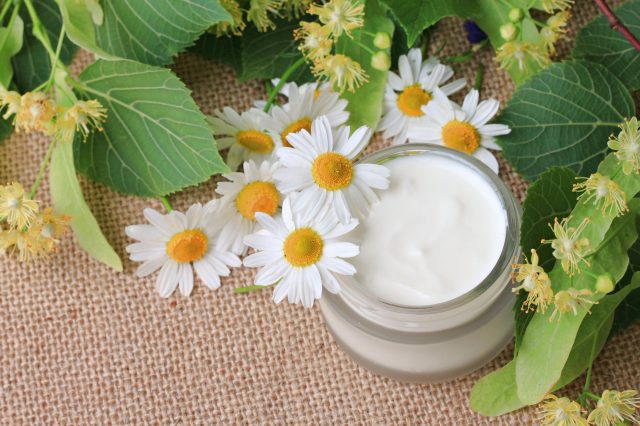 What natural ingredients help a massage therapy lotion glide with ease?
What natural ingredients help a massage therapy lotion glide with ease?
Some of the best natural ingredients you want to make sure your massage therapy lotion contains are jojoba, grapeseed, avocado or almond oil. These oils are light and airy, but are not heavy and greasy on the skin. Overtime as you are massaging, they will absorb into the skin, but they will not absorb so fast you have to stop to constantly grab more lotion to continue providing a nice gliding massage to your patient. After all, a massage therapy session is all about constant smooth flowing touch that provides healing to the body.
What massage therapy lotions are best for what skin types?
Choosing the right massage therapy lotions for the particular skin type is essential for giving a quality, yet beneficial massage therapy massage. For example, acne prone skin would benefit best from massage lotions that contain not only the oils of jojoba, grapeseed, avocado, or almond oil, but also tea tree oil since it contains antibacterial and antiseptic properties. Skin types that are sensitive and need nourishing during massage therapy to help relax the mind and body are ones that contain lavender, rosemary, rose absolute or chamomile. Skin types with stress marks, scars, signs of aging will benefit from massage lotions that contain mango, shea, or cocoa butter. Feel free to use massage therapy lotions that contain arnica in them, as it is a natural pain reliever.
What scented lotions are best to use during massage therapy sessions?
Picking out the right scented massage lotion before giving your patient a massage is important as well. Many patients are sensitive to scents and therefore we always provide an unscented lotion. However, sometimes your patients might be interested in the pleasant addition of a scented lotion. For patients that are feeling stressed, anxious, panicked or depressed lavender or patchouli scent lotions are best. Patients that want an uplifting massage might enjoy a therapy session with peppermint, or citrus could be beneficial. Picking a scented massage oil that is pleasing to your patient’s senses is beneficial for the outcome of their massage too. After all, you want their massage to feel healing and nurturing to them.
For information regarding lotion ingredients visit: http://www.safecosmetics.org/get-the-facts/chemicals-of-concern/
You can also contact Seattle Massage Schools
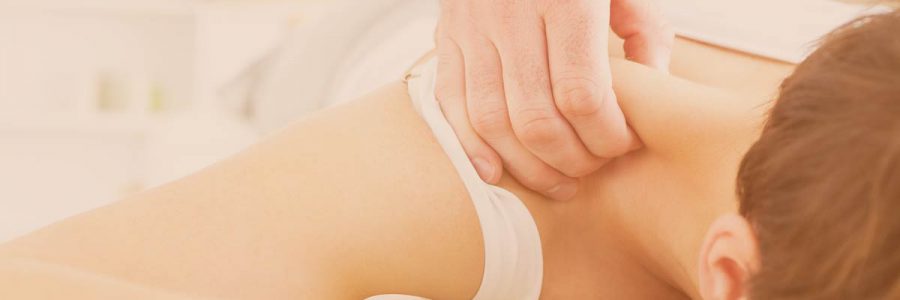
How to Succeed in Massage School – Step by Step

If you’re considering going to school to become a massage therapist, you may be as excited as you are worried. Whether massage therapy would be your first experience in a full-time job or a career change after already being in the workplace, going to school for a new skill and profession can be daunting.
But it doesn’t have to be! With a little information on your side, you can feel comfortable and even enthusiastic as you embark on this new adventure. Here are three tips on how to succeed in massage therapy school—and to be happy while doing so.
- Commit to the goal of graduation. Before you even sign up for your first class or attend your first lecture, you should decide that this is what you want to do. After that decision has been made, you will find the energy and focus that it takes to accomplish your goal. It’s just like your parents (or grandparents) always told you: “Where there’s a will, there’s a way.” If you want to achieve the goal of becoming a licensed massage therapist and actually believe that you can do it, then you will, whether it takes six months, a year, or more.
- Find a study partner or group. In massage therapy school, you’ll likely be learning about the human body in more detail than you ever have before. And when it comes to memorizing huge lists of terms in anatomy or studying a bunch of new vocabulary, having a study partner makes all the difference. Even if you think you study better alone, it’s still wise to find a fellow student or two and exchange contact information. You never know when a copy of someone else’s notes will come in handy or when you’ll need help with an assignment. Plus, when you’re in massage therapy school, it’s always nice to have a buddy to give your shoulders a nice rub when you’re feeling stressed!
- Take time for self-care. Just like an airline flight attendant will tell you to secure your own oxygen mask before helping anyone else, you’ve got to take care of your own body and mind before you’ll be able to help anyone else through a career in massage therapy. This applies to your time in massage therapy school as well; you won’t be able to fully apply yourself and focus on your coursework if you haven’t taken care of yourself first. This self-care might come in the form of meditation, scheduled time off from schoolwork, time to prepare a healthy meal, or alone time to just decompress and watch a favorite show. Whatever it is, set aside the time to do it and honor that commitment to yourself.
If you can mentally commit to massage therapy school, find a support group in your classes, and make time to take care of yourself while you do it, you’ll be prepared to succeed not only in school but in your career in massage therapy as well. And as you undertake this new journey into massage therapy school and beyond, you can feel confident that your career choice will help other people as much as it helps you.
Click here for more information about attending Seattle Massage School
8 Ways to Reduce Holiday Stress
 The biggest irony of the holiday season is that it invariably causes a lot of people a great deal of stress. The exact source of a given person’s yuletide tension can vary indefinitely, but three major circumstances are regular culprits: gift shopping, economic situation and family problems. Luckily, there exists a tried and tested list of easy ways to reduce holiday stress. These simple self-care practices work wonders for almost any source of holiday tension, also, mixing and matching them could prove to turn you into a walking source of calm and positivity.
The biggest irony of the holiday season is that it invariably causes a lot of people a great deal of stress. The exact source of a given person’s yuletide tension can vary indefinitely, but three major circumstances are regular culprits: gift shopping, economic situation and family problems. Luckily, there exists a tried and tested list of easy ways to reduce holiday stress. These simple self-care practices work wonders for almost any source of holiday tension, also, mixing and matching them could prove to turn you into a walking source of calm and positivity.
Experience the Holidays with Calm and Ease
These self-care tips may sound like common sense but for the fact that they are all too commonly overlooked. This is due in part because it’s easy to get distracted from your physical and mental condition by so much external media and situational concerns. Add to the regular worries of life the production of a successful American holiday season and you have the potential for an epic nervous breakdown. So just avoid all of that ugliness and follow these holiday life hacks.
- Do Not Overeat during the holidays because doing so will slow you down, create an imbalance in the function of your internal organs, reinforce the neural connection between ingestion and happiness and make you look like a hog at parties. Impose meal size limitations for yourself and stick to them.
- Stretching is a surefire way of reducing tension and instantly feeling better. Stretching will help you withstand standing in line at the register and the constant travel of the holidays by keeping your muscles relaxed and mind focused.
- Take a Moment to Breathe Deeply every day as this is a crucial aspect of staying balanced and relaxed. Breathing deeply is of critical importance during stretching and exercise and will help you both physically and mentally. Your body runs on oxygen remember, it is indispensable to feeling good.
- Massage Therapy is perhaps the ideal way of reducing holiday stress. A good massage therapist can identify and target tension points throughout your body. Both the quietude of a massage parlor and the physical contact of the therapist work to create a calming environment and experience that works miracles through stressful times.
- Exercise will help you channel holiday tension, enhance your metabolic functions and help you keep a focused mind, the perfect recipe for surviving the holidays.
- Shop Light if your financial situation is not great. Worrying about giving enough while still making ends meet is one of the biggest causes of holiday stress. In the words of Mother Teresa, “It’s not how much we give but how much love we put into giving.”
- Get Some “You” Time by walking through a park or scheduling a lunch date with yourself. Introspection is a key part of self-care, eliminating stress and organizing your priorities.
- Invest in Your Future instead of spending a lot of money on holiday frivolities. Taking the first step towards learning a trade or craft is a great way to add positivity to difficult times. Analyze your holiday expenditure, note where you can cut back and use it to start creating a better you.
Sure the holiday season has become synonymous with consumer madness, fiscal anxiety and family disputes, but that doesn’t mean any of it has to affect you negatively. Stay conscious of your physical health and focused on top priorities and all of stress should slide off of you effortlessly. Implement these tips year round and by the next winter you’ll be a seasoned vet in stress-free holidays.
Click Here: For more information about massage therapy or attending massage school.
8 Reasons Massage School is Worth the Financial Investment
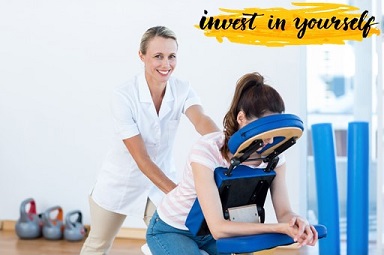
Becoming a massage therapist is a wonderful career path to follow. It is a skill you can carry with you anywhere you go. Here are 8 reasons why attending massage school is worth the financial investment.
- It’s a skill you can take with you anywhere you go. Though you may have to update your license depending on where life takes you, you will always be able to take this skill with you on the road. You can work for a massage franchise company, start your own practice or go on the road with a professional athletic team. You can even work with a cruise line and see the world.
- People love massage. Massage is often seen as a luxury, but more and more people are realizing the many health benefits that come with massage. From helping with insomnia, relieving stress and preventing and treating injuries, massage has become a perfect tool for helping people live healthier lives.
- You learn more about yourself. Massage isn’t just for helping others, it can help you learn more about yourself. Like how you handle stressful situations and what your boundaries are.
- Massage school is a great stepping stone. If you are just graduating high school or looking to transition careers, massage school is a great stepping stone for that. It pays more than your regular retail job making it ideal for a student needing to make their way to college.
- Set your own schedule. Once you graduate, setting your own schedule is fairly simple. Most massage clinics are open seven days a week. If you open your own practice, your schedule is up to you.
- Flexibility. Most massage schools have several programs to choose from. You can attend part-time or full time. You can also pick between daytime classes, evening or weekend.
- Endless opportunity to further improve yourself. Once you have your license, you have to keep it up to date and attend continuing education courses which means you get to learn more! There are always fascinating topics to pick from including aromatherapy, prenatal and infant massage as well as sports massage therapy. There are even courses in equine and canine massage!
- You can help others. Going to massage school will lead you to a path to become or enhance your nurturing skills. It’s a great way to help others live healthier lives.
What are you waiting for?
Click here: For more information bout our Massage School Programs
Click on your massage school of interest below:
Seattle Masage School | Tacoma Massage School | Bellingham Massage School
![]()





